The “Only in America” Tour—Part 2
Outlaws and Rangers: The Legend Rides On
My husband Mark says it must be a Southern thing to regularly visit one’s deceased family members at the cemetery. Living in the hills of Southwest Virginia, I thought it was totally normal to dress up on Easter Sunday and take family pictures around my grandparents’ headstone. My husband is from California and was not raised with such customs. But his grandmother was originally from Mississippi, and so Mark was probably the only boy in Fresno who grew up eating grits.
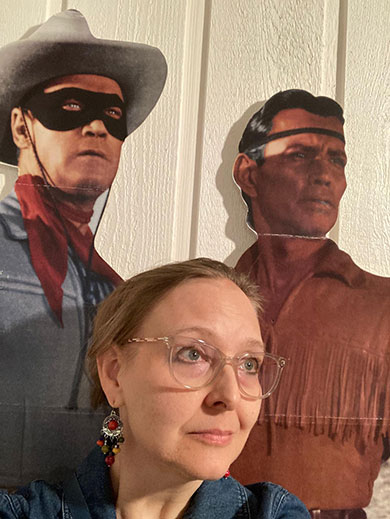
Mark and I once journeyed into the heart of the deep South—to sleepy Tylertown, Mississippi—to visit the home of his grandmother’s siblings. Sure enough, as soon as we’d drunk our first glass of sweet tea, Great Aunt Hazel drove us to the cemetery to photograph Mark with the granite markers of his kinfolks. Yep, it must be a Southern thing.
Understanding my background, you can see why I got excited to learn that Bonnie and Clyde were buried in Dallas, Texas, the first city on the “Only in America” Tour I took with my friend Thea. My college buddy hails from Westfield, New Jersey—clearly above the Mason-Dixon Line—but she didn’t flinch when I suggested we stop at the outlaws’ final resting place.
Now if you’re an American reading this blog, you are probably familiar with the story of Bonnie and Clyde. Young Bonnie Parker dreamed of becoming a famous poet or a Hollywood starlet. Clyde Barrow wanted to be a musician. But both grew up dirt poor during the Great Depression, and their opportunities for advancement were few. Destined to work dead-end jobs, Clyde determined that if he ever wanted to drive a new Ford V-8 and wear silk suits, then he would need to steal the fancy car and rob a bank. Bonnie was so smitten with Clyde, after meeting him at a friend’s party, that she was happy to go along for the ride.
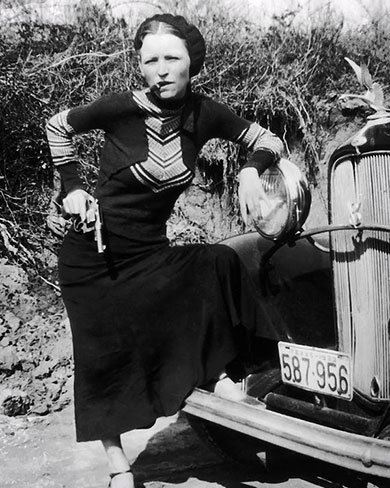
These star-crossed lovers were responsible for a 21-month crime spree from 1932 to 1934. Driving in various stolen cars, they circled through Texas, Oklahoma, Kansas, Missouri, Illinois, Arkansas, Louisiana, and New Mexico—robbing gas stations, restaurants, funeral homes, and small-town banks. Clyde and his “Barrow” Gang are believed to have murdered at least nine police officers and four civilians.
What interests me about this story is how warmly these criminals were embraced by America’s popular imagination. Working-class people at the time resented the banks, who were repossessing their homes and farms. The banks were considered the monsters; Bonnie and Clyde were the heroes, like Robin Hood, who took from the rich to give to the poor—or at least to their own impoverished relatives.
The newspapers of the time sensationalized the exploits of the young couple. Realizing that their beleaguered readers were tired of hearing about the nation’s dismal economy, editors latched onto a story that would sell. When Bonnie and Clyde made a narrow escape from a hideout in Joplin, Missouri, they left behind a camera and undeveloped rolls of film. They had photographed themselves goofing around. The Joplin Globe soon processed the film and published the pictures.
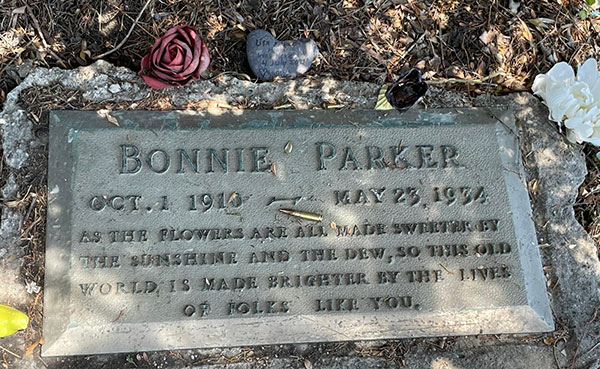
In one photograph, which eventually appeared in newspapers and magazines across the country, Bonnie is holding a gun in her hand and a cigar between her teeth. In reality, Bonnie seldom handled a gun and didn’t smoke cigars. But the image—a spunky petite woman bucking convention and living a life of adventure on the road—stuck. Her defiance of gender norms struck a chord with the emerging women’s movement. You’ll remember that the 19th Amendment, which granted women the right to vote, had only been passed in 1920. Many young women admired the free-spirited Bonnie, and she became a fashion icon.
Bonnie and Clyde continued to elude capture until two Texas Rangers, Frank Hamer and Maney Gault, were enlisted to hunt them down. The Rangers’ story is portrayed in the 2019 film The Highwaymen, starring Kevin Costner and Woody Harrelson. It is currently available on Netflix. Much of the film is historically accurate, but it takes liberties in portraying Bonnie as a vicious killer. There is no hard evidence that she ever shot another person. But since Bonnie would not part from Clyde, she was destined to suffer his fate.
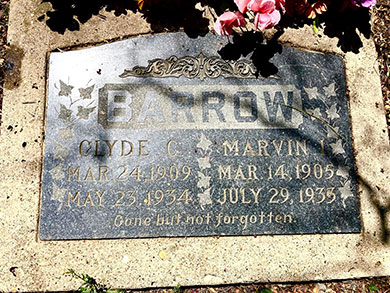
Early in Clyde’s criminal career, he had spent nearly two years at the notoriously bad Eastham Prison. As a man of small stature, standing only 5’6”, Clyde was routinely terrorized by another prisoner in the worst possible way. One observer noted that this horrific experience turned a schoolboy into a rattlesnake. Upon his release, Clyde vowed that he would rather die than return to prison.
The story reached its climax on May 23, 1934. The Rangers anticipated that Bonnie and Clyde would head south to spend time in Bienville Parish, Louisiana, at the family home of gang member Henry Methvin. Hamer and Gault enlisted the help of local law enforcement and persuaded Methvin’s father Ivy to betray Bonnie and Clyde by setting a trap. In return, the Rangers would allow Henry to live and receive immunity from prosecution in the state of Texas.
There was only one road in and one road out to reach the Methvin homeplace. As the posse lay in wait behind some nearby shrubs, Ivy parked his truck along this road and took off a wheel as if he had broken down. When Bonnie and Clyde drove in and pulled over to help Ivy, they were ambushed. When the outlaws reached for their weapons, the lawmen shot them and their stolen vehicle full of bullets.
Yet even after death, the public was still fascinated with the criminal duo: 20,000 people attended Bonnie’s funeral; 15,000 went to Clyde’s. The couple wished to be buried beside one another. In her poem, “The Ballad of Bonnie and Clyde,” Bonnie even wrote:
Some day they’ll go down together
And they’ll bury them side by side
To a few it’ll be grief, to the law a relief
But it’s death for Bonnie and Clyde.
Bonnie’s mother, however, had other ideas.
We found Bonnie’s grave beside her mother’s in Dallas’ Crown Hill Cemetery, which is poorly maintained. Across town, we saw that Clyde shares a marker with his brother in Western Heights Cemetery, which is slightly better kept. Clyde’s inscription, “Gone but not forgotten,” rings true ninety years later. Thanks to songwriters and movie-makers, the legend of Bonnie and Clyde lives on.
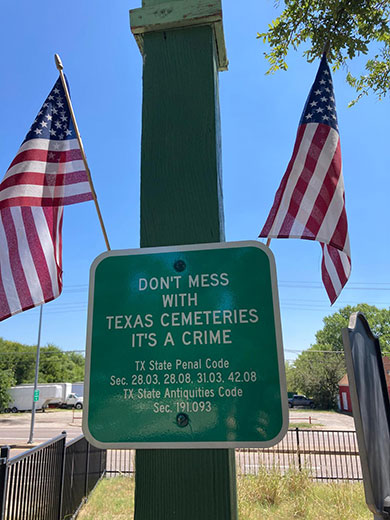
A couple days after visiting the outlaws’ graves, Thea and I traveled to the Texas Ranger Museum in Waco, Texas, to learn more about Frank Hamer and his cohorts. Apart from the biographical exhibits, I also enjoyed viewing memorabilia from fictional portrayals of the lawmen. I have many episodes of Chuck Norris’ TV series “Walker, Texas Ranger” under my belt. But for the first time in my life, I realized that the Lone Ranger was also a Texas Ranger, albeit an anonymous one. Like, duh, the Lone Ranger.
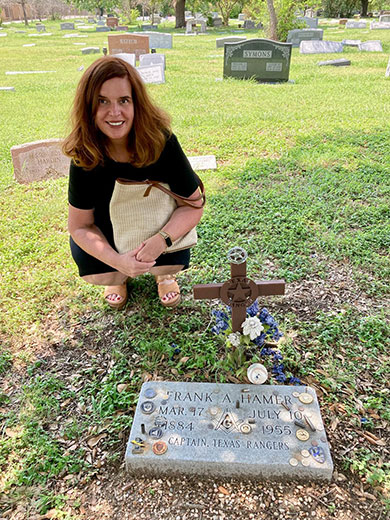
In the interest of fairness (and the lure of curiosity), Thea and I also visited the Austin cemetery where Rangers Frank Hamer and Maney Gault are buried near one another. We can still cheer for the good guys while being intrigued by the bad guys.
I think America has always liked larger-than-life heroes. In a couple weeks, children wanting candy may appear at your door dressed as Spiderman, Batman, or Wonder Woman. But even real people who do terrible deeds can become legends. While reading about Bonnie and Clyde on the internet, I ran across an interesting piece, which I believe was written by Gorbinda Sardar. Its author asks the question: “What turns a common criminal into a mythic figure?”
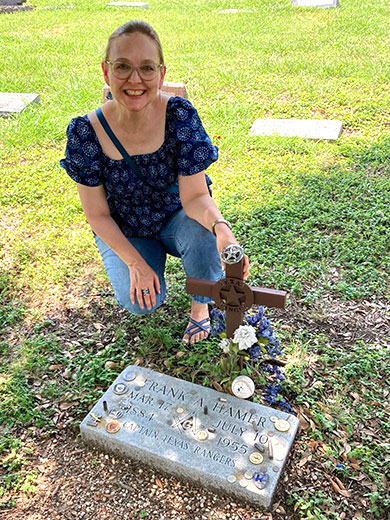
He then answers with insight: “A tragic end is imperative, a beautiful woman should play an important part in the tragedy, a betrayal, preferably by a lover or close friend is necessary…, and he must die violently at a young age.” Yep, that pretty much sums up the legend of Bonnie and Clyde.
My husband—and my readers too—may wonder why I visited the graves of these famous outlaws and lawmen. I am drawn to those of my own family members because they live on in my memory. Their granite markers serve as tangible touchstones. Perhaps I sought out the final resting place of Bonnie and Clyde and Hamer and Gault for a similar reason: they live on in my country’s collective memory. Or maybe I just have a soft spot for an aspiring poet who got distracted by a cute boy. Only in America.
Next month stay tuned for “The Day America’s Innocence Died.”

Please encourage your friends and family to subscribe by emailing Mona.
Please encourage Mona at: encouragemona@gmail.com
I included a pdf download link below, which will print out nicely for all of my paper-loving readers.
Please feel free to share it with your family and friends.
Download a pdf version of this newsletter.

